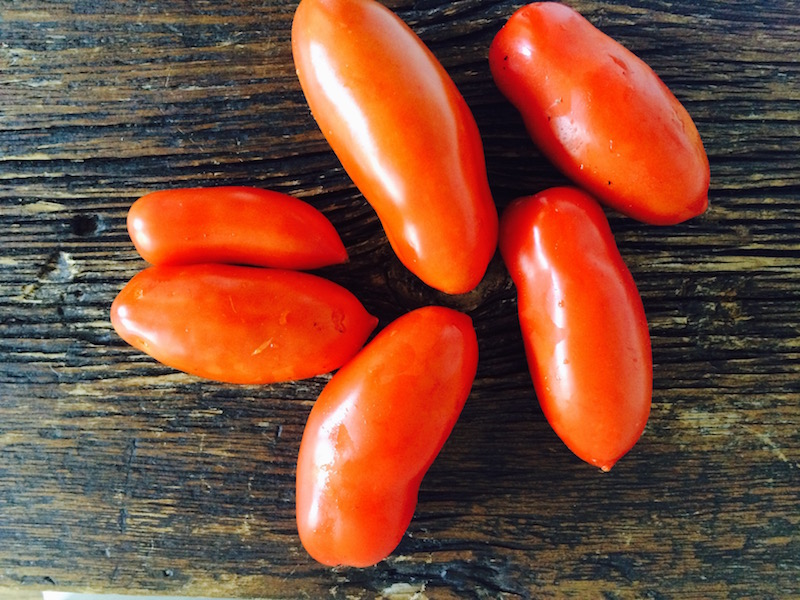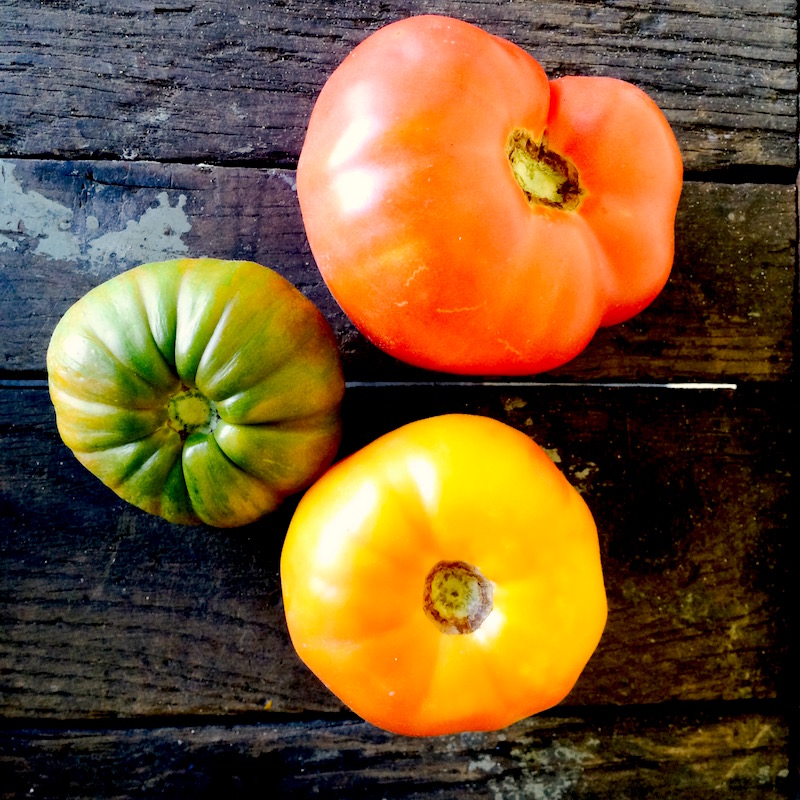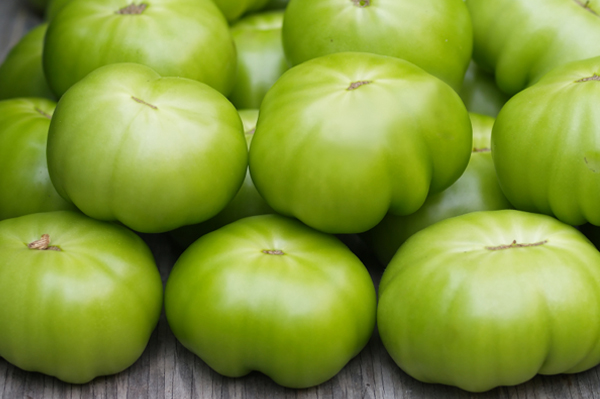Tomato Guide
If you have tomatoes growing in your garden, tomatoes from your neighbor, tomatoes in your farm share-- you might just be plum tuckered out of these Summer beauties. So we put together a guide to give you some tips and tricks for making the most of your haul.
“Tomatoes are one of those vegetable-fruits that you can do so much with. You can turn them into sauce, juice and paste; use them on pizzas and in savory pies; freeze then; can them; turn them into pickles if they didn’t ripen; dry them, and in the case of one French chef, turn them into dessert. They make terrific soups, sandwiches, and salads. They can be stuffed. And when your plants produce more fruit than you can reasonably eat, it’s good to be able to turn them into a form you can use later in the year when there aren’t any tomatoes at all.”
- Vegetable Literacy, by Deborah Madison
Age Old Question— is it a Fruit or Vegetable?
Depends on who you ask. A tomato is, botanically speaking, a fruit due to the seeds on the inside. But it is more often classified as a vegetable for most cooking purposes.
It’s a member of the nightshade family— along with eggplants, peppers and potatoes— and its primary season is the end of Summer in Ohio. Tomato plants require staking, are susceptible to many garden variety bugs so need careful tending to, and require a ton of heat and light to properly grow.
Tomato plants require staking, are susceptible to many garden variety bugs so need careful tending to, and require a ton of heat and light to properly grow. For one really successful method in home gardening, look up “5 Gallon Bucket Tomatoes” for a tutorial on growing them easily and sturdily.
Tomatoes are chock full of Lycopene, a powerful antioxidant that has the potential to protect us from many types of cancers, cataracts and other eye problems, heart disease and skin issues. And these benefits don’t go away when tomatoes are cooked— in fact, the darker the cooked end product, the more lycopene present. Lycopene is also absorbed by the body more readily along with fats, like olive and sunflower oil, common partners in crime in tomato-based dishes.
To Remove the Skin & Seeds or Not— and Why?
Tomatoes skin and seeds are both edible, but are often removed in many tomato dishes for a few reasons: the skins can become very tough when used in cooking, and can stick out and float to the top of soups and become plasticky. Especially when the weather starts to get a bit colder, the tomatoes protect themselves from the frost by developing a tougher skin. Removing the seeds and juice from the tomato is mostly for style points, but they also diminish the “tomato” flavor by watering it down.
Slicing Tomatoes (a.k.a. Beefsteak)

Large fruits, mostly round, mostly red. Your general all-purpose tomato, and many newer varieties are bred to have lower acid. Best uses: sandwiches, condiments, soups, and stuffed (Provençale style) tomatoes because of their shape.
Roma & San Marzano Tomatoes

Best tomato for sauces and paste, because they have less juice and more flesh. Oblong shaped, also great for making slow-roasted tomatoes.
Heirloom Tomatoes

Come in a variety of beautiful shapes, colors, flavors, acidity, stripes and sizes. Best eaten fresh in a Caprese salad or chopped in a fresh salsa. Can also be used in a dish where they don’t lose their integrity (i.e. not a sauce.)
Green Tomatoes

photo credit: sheknows.com
Best fried, baked, or turned to salsa. Hold their shape very well, so can also be used in fresh salsas or tarts, or can be pickled.
Cherry/Grape Tomatoes (a.k.a. “Fruit Type”)

These small tomatoes grow in clusters, similar to grapes, and grow quickly. Great backyard tomatoes. Slice into salads, or sautéed/roasted to top a side dish. These can also be frozen easily.
Tomatillos

Also known as 'Mexican Husk Tomatoes,' these are a close relative to Ground Cherries (gooseberries) and are a member of the nightshade family (along with other tomatoes and eggplant.) Best cooked into a salsa or sauce.
Storing Fresh Tomatoes
As soon as you get your tomatoes home, or once you’ve picked them from your garden, give them a wash and then gently dry them. Store them in a bowl with some breathing room on your countertop or somewhere warmish and enjoy within a few days. Fresh tomatoes do not like the cold of the fridge— but if they start to crack, or you have a half-used tomato, store in the fridge or freeze.
Freezing Tomatoes
First blanch your tomatoes to remove the skins. The term “blanching” comes from the French word for white or whiten. It was originally a process for whitening clothes. The temperature of the vegetables is change quickly from very hot to very cold. This sudden change of temperature causes the vegetable to contract. Some chefs refer to the process as “shock the vegetables.” Most noticeable in the process is the change in color. In the case of tomatoes, the process makes removing the skin quick and easy.
Cut a small X with the tip of sharp knife into the bottom of the tomato and drop into boiling water for just 2 minutes. Remove with a slotted spoon and plunge right away into ice water to cool. Carefully peel the tomato.
Slice into sections and remove the juice and seeds. Freeze these tomatoes in chunks for easy use. Cherry and grape tomatoes can be frozen in a single layer on a cookie sheet and popped into a ziplock bag.
Tomato Sauce
Making a simple tomato sauce is one of the best ways to store a lot of tomatoes and used all winter for pizzas, pasta sauces, soups or stews. This is also a great use for tomatoes that have any spots or bruises, but are otherwise perfectly good tomatoes. Just core the tomatoes and cut away any bruised parts before making the sauce. It can be frozen in labeled freezer-safe containers, or canned.
Special note on canning— find a tested recipe and follow it exactly to make sure you achieve the correct level of acidity, especially if you’re canning using a water bath. Many canned tomato sauce recipes require the addition of lemon juice or vinegar to bring the pH into a safe range.
Tomato Ketchup & Paste
From a basic tomato sauce you can make many tomato condiments: it’s the same difference as between apple sauce and apple butter, basically just a further reduced and seasoned version. As more liquid is cooked off, they become sweeter and more strongly flavored. Some great recipes to try: tomato jam, homemade ketchup, chutney, preserves and BBQ sauce.
Dehydrating (Oven-Dried) Tomatoes
Slowly cooking whole or half tomatoes in the oven dehydrates them, and allows them to be stored with an intensified flavor. Lightly season with olive oil, Italian herbs, salt and pepper, and roast on very low heat for a long time— overnight, even— checking occasionally to make sure they don't burn.
Sharpened Knife
A good chef’s knife— about 8 inches, with regular sharpening— will help you slice your tomatoes safely and easily. Trevor also uses a serrated knife more often for tomatoes than for bread! Never needs sharpening and gets through even the thickest skinned 'maters.
Food Mill
A food mill is an extremely useful and inexpensive kitchen tool. You’ll notice it’s mentioned in many of our recipe and guides. It removes only the thickest parts of pulps, skins, and seeds so that what you’re left with is a rich sauce with a little bit of taste and texture. Excellent and very important for making sauces.
Food Processor or Vitamix
Owning a good blender, food processor or Vitamix is an essential kitchen tool for most recipes especially those involving tomatoes.
